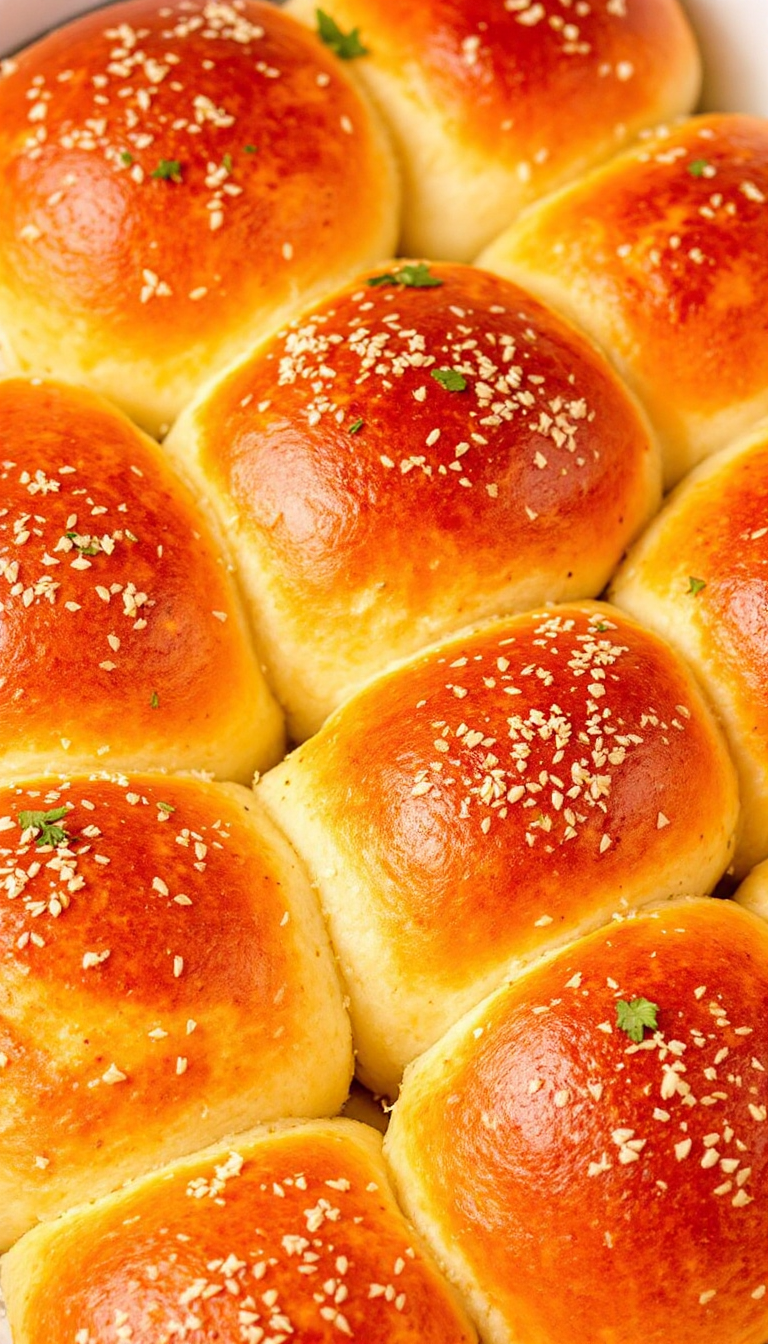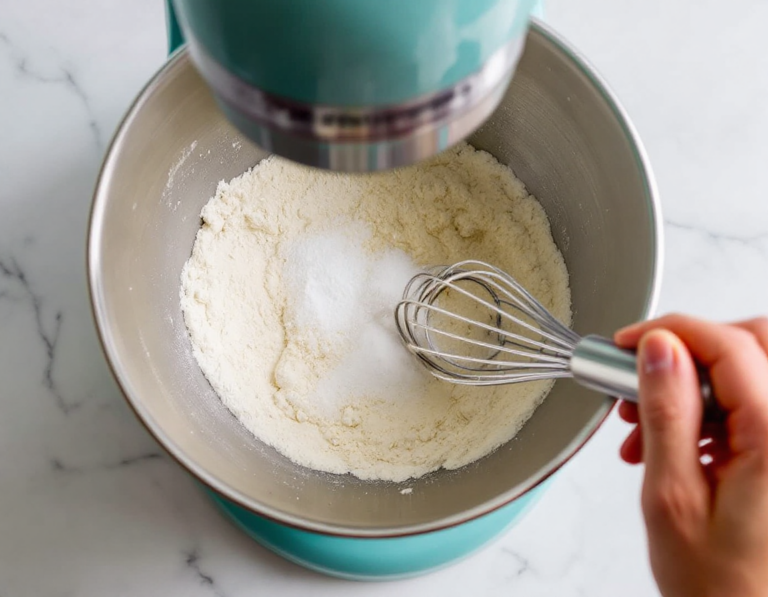There’s something truly satisfying about biting into a soft, warm dinner roll. When you’re gluten-free, finding a good one can be a challenge.
This recipe changes that. These easy gluten-free dinner rolls are fluffy, delicious, and perfect for any meal.
With simple ingredients and minimal prep, you can enjoy them fresh out of the oven in no time. Let’s get baking!
Steps
- In a stand mixer bowl, combine the gluten-free flour, xanthan gum, tapioca starch, instant yeast, and sugar. Whisk the ingredients together thoroughly, then add salt and whisk again.
- Add the warm milk, melted butter, and egg whites to the dry ingredients. Use the paddle attachment to beat the mixture vigorously until it clumps together, clears the bowl’s sides, and then becomes whipped and sticky again (about 6 minutes).
- Transfer the dough to a lightly oiled container with a tight-fitting lid. Allow it to rest at room temperature for at least 2 hours, or refrigerate for up to 24 hours, ensuring it doesn’t rest too long to prevent irregular rising.
- If refrigerated, bring the dough to room temperature. Grease your baking pan, and decide if you want the rolls touching or spaced apart for baking.
- Divide the dough into 16 equal pieces, each about 2.5 ounces. Knead each piece with your hands, pinching any seams, and shape into rounds on a lightly floured surface using tapioca starch.
- Arrange the dough rounds in the prepared pan as desired, cover with greased plastic wrap, and let them rise in a warm, draft-free spot until they are about 150% of their original size.
- Preheat the oven to 375°F. Once the rolls have risen, remove the plastic wrap, and brush them with melted butter on all exposed sides.
- Bake in the center of the preheated oven until a thermometer reads 190°F in the center of a roll. If rolls are touching, lower the temperature to 350°F after 18 minutes and continue baking for around 5 more minutes.
- Once baked, remove from the oven and brush with more melted butter while still in the hot pan. Serve the rolls immediately.
Ingredients
- 3 ¼ cups (455 g) all-purpose gluten-free flour blend (Better Batter recommended)
- 3 ¼ teaspoons xanthan gum (omit if your flour blend already contains it)
- ? cup (105 g) tapioca starch/flour, plus more for sprinkling
- 4 teaspoons (12 g) instant yeast
- ¼ cup (50 g) granulated sugar
- 1 teaspoon kosher salt
- 1 ? cups (13 fluid ounces) warm milk (approximately 90°F)
- 8 tablespoons (112 g) unsalted butter, melted and cooled (plus more for brushing)
- 2 egg whites (50 g), at room temperature
Nutritional Values
Calories: 1808kcal | Carbohydrates: 544g | Protein: 48g | Fat: 112g | Saturated Fat: 64g | Polyunsaturated Fat: 3.2g | Monounsaturated Fat: 32g | Trans Fat: 3.2g | Cholesterol: 288mg | Sodium: 3136mg | Potassium: 1232mg | Fiber: 32g | Sugar: 64g | Vitamin A: 3440IU | Vitamin C: 0.16mg | Calcium: 528mg | Iron: 3.2mg
FAQ
- Why didn’t my gluten-free rolls rise?
- Your gluten-free dinner rolls might not have risen due to several factors. Common issues include using too much flour, which decreases the dough’s hydration and inhibits yeast activation, or not using enough sugar to feed the yeast. Also, incorrect milk temperatures can affect yeast activity; milk that’s too cold slows activation, while milk that’s too hot kills the yeast. Additionally, expired yeast or a drafty environment can impede the rising process.
- What causes my gluten-free rolls to be dense?
- Dense rolls are often the result of overusing flour, which is why it’s crucial to measure flour with a kitchen scale rather than a measuring cup. Avoid adding excess flour during the shaping process, as this can lower the dough’s hydration and inhibit yeast activity.
- Can I freeze these gluten-free rolls?
- Yes, freezing gluten-free rolls is an efficient way to save time. Follow the instructions for shaping and parbaking the rolls, then freeze them once they are fully cooled. When you’re ready to eat, let them defrost and finish baking them in the oven.
- What if I only have active dry yeast instead of instant yeast?
- You can use active dry yeast, but you’ll need to use 25% more than the recipe’s instant yeast requirement and dissolve it in some of the milk before mixing with the other ingredients. For instance, if the recipe requires 12 grams of instant yeast, you’ll need 15 grams of active dry yeast.
- Can gluten-free flour be used to make yeasted rolls?
- Absolutely, gluten-free flour can be used to make yeasted rolls. The key is precise measurement of ingredients and using the correct gluten-free flour blend as specified in the recipe to ensure successful rising.
- Can I leave out the tapioca starch if my flour blend already contains it?
- No, you shouldn’t omit the tapioca starch. The recipe requires both the specific flour blend amount and additional tapioca starch. Leaving out essential ingredients can lead to unsatisfactory results unless the ingredient is marked as optional.
Tips
- Use a Kitchen Scale for Precision: Ensure accuracy in measuring gluten-free flour by using a kitchen scale. This precision helps achieve consistent results, avoiding dense rolls due to incorrect flour amounts.
- Create the Right Environment for Rising: Allow the dough to rise in a warm, draft-free area, ideally on top of a preheated oven. Avoid overly hot temperatures to prevent killing the yeast and hindering the rise.
- Eat Fresh for Best Texture: Enjoy the rolls immediately after baking for the best texture and flavor. If you anticipate having leftovers, consider making a smaller batch to avoid storage issues.
- Consider Parbaking for Advance Preparation: If you need to prepare rolls in advance, parbake them, freeze, and then finish baking when needed. This method maintains their quality and saves time for later use.
Equipment
- Stand Mixer – Essential for mixing the dough properly to achieve the desired texture for the gluten-free rolls.
- Food Processor with Steel Blade – An alternative to the stand mixer if you don’t have one, though less common.
- Instant Read Thermometer – For checking the internal temperature of the rolls to ensure they are fully baked.
- Kitchen Scale – Important for accurately measuring ingredients, especially crucial in gluten-free baking.


